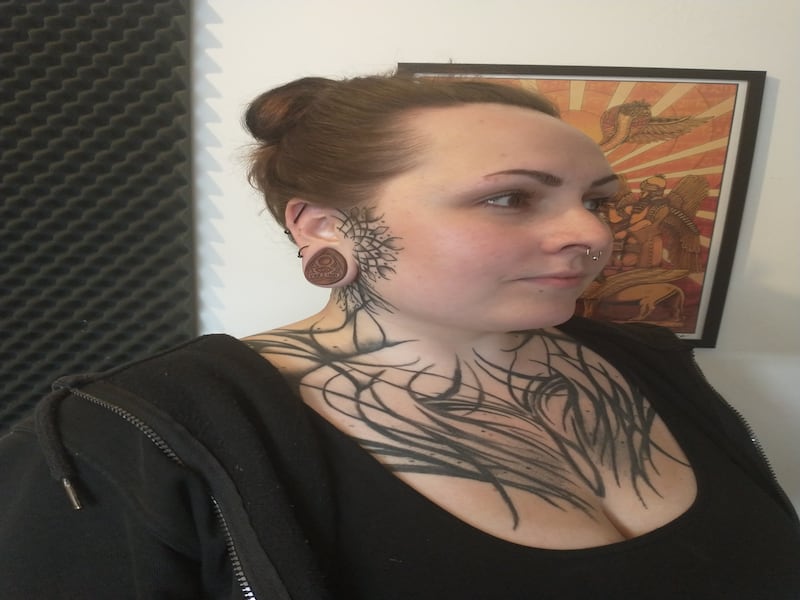Impulsive by nature, Tanya Louise Heaphy says she is lucky her tattoo artist sends her away to think about her requests before he puts ink to her skin.
The 28-year-old Cork resident has tattoos on her arms and an intricate pattern of black strokes that weave across her chest, up her neck and along the ear-side of her right cheek.
So far, she has no regrets and says she has not run into difficulty securing employment in the retail sector.
Having interviewed for her current retail position remotely, Ms Heaphy informed the employer she had visible tattoos, and “they were fine with it”. As for her role in a band, she says her body art compliments the style and is a form of expression.
READ MORE
If she is rejected for a job in future due to her tattoos, Ms Heaphy says she will know it was “not for me”.
Thankfully, she has not set her sights on a position in An Garda Síochána.
If you are good at your job, I just cannot see how having a tattoo affects your work as a police officer or as someone who works with the public
— Tanya Louise Heaphy
Earlier this week, it emerged that three trainee gardaí were sent home from Templemore due to their tattoos being visible while they were in uniform.
An Garda Síochána has a strict dress code that forbids tattoos on the face or visible above the collar.
“All other tattoos must be covered at all times while on duty, whether in uniform or plain clothes,” the 2021 policy document states.

Ms Heaphy feels the policy is “a bit ridiculous” and outdated as the employer is “going off the person’s image”.
“If you are good at your job, I just cannot see how having a tattoo affects your work as a police officer or as someone who works with the public,” she says.
The president of the Garda Representative Association (GRA) Brendan O’Connor described the sending home of three recruits as “a little bit conservative”. The force needed to be more inclusive and to “reach out beyond” where it has traditionally been when it comes to recruits, he said this week.
“It does seem that perhaps this policy is slightly out of step and is robbing the organisation of three people with the potential to be excellent guards and serve the community well.”
[ Brianna Parkins: Why should a visible tattoo stop you from becoming a garda?Opens in new window ]
People with face, neck and hand tattoos will run into difficulty with some other prospective employers. In the tattoo trade, ink designs in these areas are referred to as “jobstoppers”.
The Defence Forces draws a line above the shirt collar.
A spokesman said: “A tattoo above the shirt collar, observed at any stage during the induction process, will normally result in an applicant not being offered a place in the Defence Forces.”
Tattoos are allowed elsewhere on the body unless they are extremist, sexist, racist or advocate illegal drug use.
‘Careful consideration’
Britain’s defence forces relaxed its policy in 2014, permitting tattoos on the back of a recruit’s neck and anywhere else that would not be visible in a passport photo.
London’s Metropolitan police force has since October of last year adopted a similar line, allowing officers to ink their hands and back of their necks but nothing above the shirt collar at the front. Police officers are required to cover their tattoos when it is seen as appropriate for certain policing events, such as state funerals and remembrance parades.
A spokesman for the Health Service Executive said it has ‘no tattooing policy for staff’. No one has been fired or failed the recruitment process due to having visible tattoos, he added
The Police Service of Northern Ireland will give “careful consideration” to any tattoos on the head, face, neck and hands as to their size, nature and prominence. They will be deemed unacceptable if contrary to equality laws or if they could reasonably be interpreted as offensive to members of the public or colleagues.
All applicants are required to supply photographs of their tattoos as a condition of the recruitment process.
A spokesman for the Health Service Executive said it has “no tattooing policy for staff”. No one has been fired or failed the recruitment process due to having visible tattoos, he added.
[ Tattoos have reached a turning point at workOpens in new window ]
Aircraft passengers may have noticed that the hands pointing to exits to their left and right are free from ink designs. Ryanair and Aer Lingus both stipulate that tattoos should be not visible when staff are in uniform.
However, Richard Branson’s Virgin Atlantic airline announced in May of last year that it was doing away with its no-show policy. The move to allow cabin crew to “show off their ink to the world” was part of the airline’s campaign aimed at championing its people’s individuality and uniqueness.
Meanwhile, there has been a “definite shift” in how professional services companies approach visible tattoos, according to Trayc Keevans, who is the Irish-based global research director at recruitment agency Morgan McKinley.
‘More open’
Businesses particularly concerned with “diversity, equity and inclusion” targets, are “more open” in their approach as “they see tattoos as a form of expression”, she says.
Tattoo policies, if in place, are contained in employee handbooks rather than in recruitment advertisements, so jobseekers tend not to know up front if theirs will be a problem, she goes on.
Anyone with visible words or symbols that express political views could run into issues, Ms Keevans adds. The same applies to people with large neck and face tattoos seeking client-facing roles.
The more traditional sectors, such as finance, may be stricter in their policies concerning staff who meet clients, while “pretty much anything goes” for many design and technology roles.
Most companies are focused on an interviewee’s skills rather than their skin, she adds.
One has to squint to see the tattoos on Fionnuala Coffey’s hands. The interweaving patterns across the back of her hand are in a white ink that largely blends into her skin.
Regardless, a tattoo’s prominence would certainly not be a stain on her role as manager of Connected Ink tattoo parlour in Dublin’s Temple Bar.
Ms Coffey, who has worked in the trade for nearly 20 years, says it used to be that only people already covered in ink would request a new piece on “jobstopper” areas.
Now, because of pop star trends and social media, more people, especially younger women, come in seeking small designs on their hands or neck as their first tattoo, she says. Tiny prints on these areas age badly due to exposure to the elements, she adds.
Consent form
The parlour requires people to sign an additional consent form before proceeding to ink visible areas.
“They are adults and there are so many tattoo shops in this area. They can easily walk into another shop,” she says.
She cautions these young people that it could narrow their job opportunities or be a bad look if they ever find themselves in court.
No such warning was needed for one recent client: a woman in her 80s who came from her retirement home to get a large bluebird on her hand.
Grinning, Ms Coffey adds: “If any 80-year-old comes in wanting a hand tattoo we will just rock‘n’roll.”
Appearance matters: Garda rules go beyond tattoos
The policing of Garda appearances goes far beyond any patterns on their skin, as the organisation’s dress code emphasises the need to look smart, neat and professional when on duty.
Gardaí are not allowed to dye their hair “conspicuously unnatural colours”, while men must keep theirs short, tidy and above the ears.
Make-up may be worn but “must not under any circumstance be excessive”. Forbidden are any coloured nail polish, false nails and piercings other than “one set of small stud-type earrings”.
The current uniform policy, introduced in July 2021, permits gardaí for the first time to grow beards and moustaches that were previously the preserve of those working undercover. However, beards must be between 0.5cm and 2cm in bulk, and “no portion of moustache will extend beyond the corners of the mouth or fall below a line parallel with the bottom of the lower lip”.
An unshaven or stubbly look is “unacceptable”, the policy states, so those aspiring to a beard must begin growing it during annual leave or rest days so they do not appear unprofessional during the initial growth stage.
The issue of garda beard growth was taken up in 2001 by Garda whistleblower John Wilson, now retired. A former rank-and-file garda, Mr Wilson sought the right to have a beard on grounds of an unusual skin condition and was eventually successful.
The relaxation of the facial hair rules came as part of the Garda’s push to promote greater diversity, equality and inclusion in the force.
The organisation also began to permit the wearing of turbans, prayer hats, burkas and other headgear associated with a member’s religion.



















